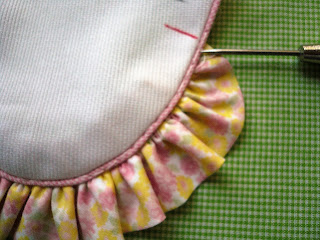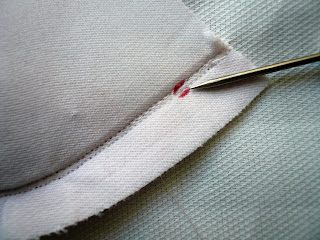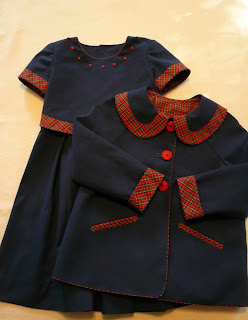Fabric Ruffle, Piped, Peter Pan Collar
1. Using a #2 pencil, trace the collar outline
(make sure to flip the pattern over to make a left and a right collar) onto the
right side of a block of fabric. Be
careful to line up the grain line of the collar to the grain line of the
fabric. DO NOT cut out the collar. Mark the center front, center back, and the
shoulder line.
2. Fuse lightweight interfacing to the wrong
side of the collar fabric block. For
lightweight fabrics an alternative to interfacing is to use two layers of the
outer fabric.
3. Cut bias strips to the following widths
(depending on chosen seam allowance):
·
¾” wide for ¼” seam
allowances
·
1”
wide for ⅜” seam allowances
·
1
¼” wide for ½” seam allowances
·
1
½” wide for ⅝” seam allowances
Wrap
the bias strip around the filler cord and use a zipper foot, five groove
pintuck foot, cording foot, or open toe applique foot to stitch close to, but
not catching the filler cord. There
should be the width of one needle between the stitching and the cord. Use a 2.5 stitch length.
4. Cut a length of
piping the approximate length of the collar perimeter. Clip into the piping seam allowance at ½”
intervals. Steam shape the piping to the
perimeter of the collar. Stitch the
piping (2.0L) to the collar, stitching just inside the stitching line on the
piping. Be careful to keep the raw edges
of the piping aligned to the drawn collar perimeter. Do not stretch the piping while stitching.
2. Cut out the
interfaced, piped collar front on the perimeter pencil line. Cut out the neckline curve ½” from the pencil
line.
3. Using a steam iron, gently press the piping
into its finished position, easing in the seam allowances on the wrong side of
the collar. It will look lumpy...don't panic. All that excess seam allowance will end up being cut off.
4. For a ¾” wide finished ruffle cut 2 ¼” bide
bias strips twice the length of the finished collar edge. Fold the bias strips in half (lengthwise and
wrong sides together) and press. Use the
ruffle guide provided to shape both ends of the collar ruffle.
5. Run two rows of
gathering threads (3.0L), one at ⅛” and the second at ⅜” away from the cut
edges of the collar ruffle. Mark the
center point and gather up the collar ruffle to the finished collar
measurement. Pull from each end in
toward the center point.
6. Mark the center front and the center back
SEAMLINE (not cutting line) on the piped collar. These marks are where the collar ruffle
should end.
7. Working from the right side, pin the
gathered up ruffle to the wrong side of the collar having the ⅜” gathering
thread line positioned just beyond the piped edge of the collar.
8. Machine baste (5.0L) right along the piping,
holding the gathered ruffle in its finished position. Be sure the ruffle begins and ends at the
marked center front and center back SEAMLINES.
9. Flip the seam allowances back out, which will
force the ruffle toward the center of the collar. The basting line from Step 8 will keep the
ruffle in its correct position while you proceed with the finishing steps of
the collar.
10. Matching fabric grain lines and right sides
together, lay the collar front over the collar backing, sandwiching the piping
and the ruffle in the middle. Pin in
place.
11. Stitch (1.5L) right on top of the stitching
line from the application of the piping.
Stitch again (1.5L), a scant 1/16” away from the first stitching line.
12.
Trim through all layers very close to the second stitching line around the
perimeter of the collar.
13. Remove the basting thread lines from the
piping and the inner edge of the gathered ruffle. I do not cut out along the neckline cutting line until I am ready to sew the collar into the neckline of the garment. This prevents the collar from stretching during preparation.







































































